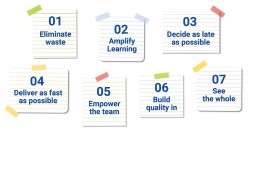Sprint Planning Meeting
In the Sprint Planning Meeting the project team discusses the goals of the next Sprint.
The Development Team selects from the top of the Product Backlog the number of User Stories they can accomplish in the next Sprint.
So the question is “How much can we create in this Sprint?”.
The Development Team discusses and decides how the work will be done and how the goal of the Sprint will be achieved.
Product Backlog Grooming
The Product Backlog is owned by the Product Owner.
Grooming is done by:
- adding
- removing
- (re-)prioritizing
- decomposing
- enriching / detailing
requirements, which can be bugs, technical dept, features or stories.
Normally an Issue Tracking System is used, e.g. Jira. So it’s easy to trace this.
Usually the Product Owner does this in close cooperation with the Stakeholders and the Development Team.
Prioritization can be made by considering the following 3 aspects:
- Business Impact
- Risk*
- Necessity/Urgency
* = The risk of a requirement can be determined by analyzing the dependencies to other issues.
A Product Backlog should have at least the top 2 stories “ready-to-implement” stories, normally as much stories that are sufficient for the next Sprint, but never more ready stories than the Development Team is able to implement in 3 Sprints. Further stories, with a lower priority should be only kept vague, so that the knowledge base on which the detailing is made is always as current as possible.
Grooming Workshops
The Product Owner can additionally invite the whole Development Team (and may be also some stakeholders) to a weekly or bi-weekly “Grooming Workshop” or “Grooming Meeting” or “Refinement Meeting”. It can be very useful to choose one big theme / topic. So don’t talk about 20 stories, but some related stories. Optionally the Product Owner can have a 1 hour Pre-Grooming Meeting with one Lead Developer to get at least 1 team member on board upfront and to identify what needs more preperation.
Frequency
Every 1-2 weeks
Duration
A good duration is 1-1.5 hours
Goal
During the Grooming Workshop the Product Owner will find out, if the stories are too big, too small, too detailed, too unclear by using some techniques e.g. Planning Poker. There will be much knowledge transfer within this meeting. Also Acceptance Criteria for stories can be collected together.
Development Team
A self-organizing, cross-functional team with 2-8 members (architects/developers/testers). In a Sprint the team stays fix, changes can happen with the next Sprint.
Goal (what)
Achieve the Sprints goal and create a valueable, deliverable increment / iteration of a product at the end of every Sprint
Main tasks (how)
- Estimate effort of user stories (helping the product owner to priotitize the product backlog)
- Estimate capacity for a sprint (think of free days, sick days, delays due to late approval, delays due to urgent issues, QA)
- Define tasks for each user story
- Program (accomplish the different stories of the sprint backlog)
- Testing
Artifacts responsible for
Events / ceremonies / activities to attend
- Product Backlog Refinement
- Sprint Planning Meeting
- Product Development
- Daily Scrum Meeting
- Sprint Review Meeting
- Sprint Retrospective Meeting
Scrum Master
Definition & Goal (what)
The SCRUM Master is responsible for the SCRUM process. He ensures that SCRUM is correctly and efficient used.
Goal:
Ensure the SCRUM methology is used effectively and the team performs at its best
Main tasks (how)
- Chair & facilitate meetings
- Update burn down chart / burn up chart
- Communicate SCRUM methology
- Remove impediments / road blocks
- Coaches the team to its best performance
- Ensures close cooperation across the team
- Shield the team from external interference
Artifacts responsible for
Events / ceremonies / activities to attend
Details
The Scrum Master is responsible for a working SCRUM process. He works with the Developement Team but is not part of it. He introduces the rules of SCRUM and takes road blocks out of the Development Teams way. He takes care of good and enough communication and cooperation within the Development Team of between the team and the Product Owner.
A Scrum Master is a servant leader. He does not do “command and control”. A SCRUM Master does not judge anyone. He is coaching and educating every member of the SCRUM team in doing SCRUM right and removes impediments.
If a company switches its processes to SCRUM the SCRUM Master will change all processes, procedures and educates everyone in doing SCRUM. A SCRUM Master is a change manager introducing SCRUM in the whole company and is an advocate for the acceptance of SCRUM.
Product Owner
Definition (what)
The Product Owner represents the customer/stakeholders for the product which we are developing.
Goal (what)
Ensure maximum value for the product
Main tasks (how)
- Create a product vision
- Identify and prioritize requirements after talking to executives, stakeholders, team, customers and users
- Write User Stories based on these requirements
- Describe the scope of a requirement
- Defines User Stories for the next sprint in detail (inkl. Acceptance Criteria) – the stories must be easy to understand for everyone
- (re-)rioritize the stories
- At the end of each Sprint (in the sprint review) the Product Owner (PO) explains which stories are “done” and which not and why – He accepts or rejects work results
- Optional: Cancel the current sprint if the goal of the sprint is obsolete now
Artifacts responsible for
Events / ceremonies / activities to attend
Details
The Product Owner is responsible for the economic success of the product. He strives to maximize the products benefits (USPs / Unique Selling Points). The PO creates, prioritizes and clarifies the requirements (features) for the product and at the end of each Sprint he judges which User Stories are complete.
He needs to find a balance between requirements, time of delivery and costs.
The Product Owner confers frequently with other stakeholders (e.g. customers, users, management) to understand their needs. It is a challenge to find a balance between all those needs, which may compete with each other.
7 core concepts of Lean
Lean leverages 7 core concepts:
- Eliminate Waste
- Amplify learning
- Deliver as fast as possible
- Decide as late as possible
- Empower the team
- Build quality in
- See and optimize the whole
The most important one and key success driver, according to my experience, is the following one:
Eliminate waste
So, check what of the following things you can remove at work:
- partially done work (at least consider this)
- extra procedures
- extra (not core) features
- to much task switching
- waiting times
- defects and things littered with mistakes
Stumbled the concept
If you’re not sure how much time you are actually spending on various tasks, use a tool like Rescue Time (their free version is excellent!) which runs in the background and tracks where your time is being spent. It can even send you weekly reports so you know exactly how much time you wasted on Facebook, or spent in your email inbox! You can assign different websites or programs/applications on a scale of very distracting to very productive, so you can see at a glance things like: which days of the week you’re most productive, which times of the day you’re most productive, and the sites on which you’re spending the most distracting time. I stumbled upon the concept of margin while reading a post by Michael Hyatt, which led me to design my ideal week.
Richard Swenson, M.D. (who wrote the book: Margin: Restoring Emotional, Physical, Financial, and Time Reserves to Overloaded Lives) describes margin like this:
Last year I wrote about why booking too far in advance can be dangerous for your business, and this concept of margin so eloquently captures what I had recognized had been my problem: I was so booked up with clients that I wasn’t leaving any margin for error, growth, planning, or reflection. I wasn’t really growing my business in a sustainable way; I was just booking one client after the next. At the time this seemed like a good thing: doesn’t growing my business mean getting more clients?
What if instead of booking up to 100% capacity (which more often than not ends up being closer to 120%), we only booked up to an 80% capacity?
What if we left more room for growth (personal or professional) and stopped being one with “busy-ness”?
I spent nearly a year turning down every new project (and even getting rid of old ones) so that I could reduce my workload, build in more margin, and create what is now Digital Strategy School. It takes time to build margin into your schedule.
What could you accomplish with 20% more time?
Write a book. Create a program. Update your contracts and proposals (which has been on your to-do list for how long..?) Spend more time with your family. Go above and beyond for a client. Learn something new. Actually follow through on the things that have been nagging at you for a long time.
When you design your ideal week, you start to see that the time you think you have is often not in alignment with how much time you actually have.
After designing my ideal week, I had a much clearer idea of how to create a framework for my week that would empower me to feel more focused by theming days of the week, and even parts of the day. SO simple, I know. Some of you have been doing this for ages and you’re already a pro, and some of you who saw my schedule said “woah, that’s so rigid, I need more flexibility!”
Structure enables flexibility.
If you’re not sure how much time you are actually spending on various tasks, use a tool like Rescue Time (their free version is excellent!) which runs in the background and tracks where your time is being spent. It can even send you weekly reports so you know exactly how much time you wasted on Facebook, or spent in your email inbox! You can assign different websites or programs/applications on a scale of very distracting to very productive, so you can see at a glance things like: which days of the week you’re most productive, which times of the day you’re most productive, and the sites on which you’re spending the most distracting time. Turns out I’m consistently “in the zone” around 3pm in the afternoon; so instead of trying to tackle highly creative work first thing in the morning (when my brain is barely functioning), I handle it in the afternoon, when I know I’m at my peak!
Creating more margin has been game-changing for my business.
What would be possible for yours?
Kanban
Kanban is the Japanese word for “sign board”.
It is a task board way to vizualize the workflow and it is very easy to mark tasks with blocks during the Daily SCRUM.
In SCRUM the task board (KANBAN) has typically 6 columns:
- ToDo 1: Backlog (User Stories)
- ToDo: Tasks
- In Progress – 1: Developement
- In Progress – 2: Testing
- In Progress – 3: Deployment
- Done
But if you never worked with this before, you could easily start with this most simple board:
- ToDo
- Doing
- Done
…and then put in more details with each further project.
Details
Buy the way there are some things I like very much:
In KANBAN there are often 2 testers responsible to test a task.
You can introduce a “Priority Lane” e.g for stories / tasks that are very urgent.
Primarily a Kanban board is used in the Agile Methodology “Lean”, but also in SCRUM and XP (Extreme Programming) used.



